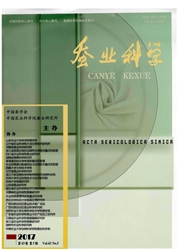

 中文摘要:
中文摘要:
昆虫化学感受蛋白(CSPs)是一类小分子质量的水溶性蛋白质,广泛分布于昆虫的各种化学感受器中,具有多种生理功能。以家蚕为模式,研究csp9基因与CSP9蛋白在家蚕不同发育阶段以及5龄幼虫不同部位和器官的表达特征,为进一步阐明家蚕乃至昆虫CSPs的功能和作用机制提供有益信息。qRT-PCR检测csp9基因在家蚕5龄幼虫头部、胸部、腹部和尾部的表达水平较高,而体内组织中仅在卵巢有少量表达;CSP9蛋白的免疫荧光定位分析显示CSP9蛋白广泛分布于各龄幼虫头部、腹部、尾部的体表感受器。利用qRT-PCR和Western杂交检测分析csp9基因以及CSPs蛋白在家蚕幼虫和蛹的不同发育时期的表达均呈现明显的规律性变化:在幼虫各龄眠蚕的表达水平较低,至眠起出现升高,取食12 h后下降;5龄末吐丝前的表达水平又急剧上升,直到化蛹后2 d再次下降,蛹末期(羽化前)又有所上升。由此推测CSP9蛋白不仅与幼虫体表感受器的功能有关,而且可能在家蚕不同时期发育变态过程中发挥重要作用。
 英文摘要:
英文摘要:
Chemosensory proteins (CSPs) are small soluble proteins abundantly distributed in various chemosensory or- gans of insects. They have many different physiological functions. In the model insect silkworm ( Bombyx mori), the expres- sion pattern of csp9 gene and CSP9 protein at different development stages and in different tissues and organs of the 5th instar larvae were investigated, which will provide useful information for further function and mechanism analysis of silkworm and insect CSPs. qRT-PCR analysis indicated that csp9 gene had high expression levels in head, thorax, abdomen and caudal parts of silkworm larvae of the 5th instar while among the internal organs only ovary was found to have csp9 expres- sion. Immunofluorescent localization indicated extensive distribution of CSP9 in epidermal chemosensory organs of head, abdomen and tail throughout the larval stage, qRT-PCR and Western blot analyses showed that CSP9 has obvious regular expression patterns at different developmental stages of silkworm larva and pupa. The expression level was low in all themolting larvae. It started to increase in newly exuviated larvae, then decreased at 12 h after feeding. Expression of CSP9 increased rapidly again at end of the 5th instar before spinning and decreased at 2 d after pupation, then increased again at the end of pupa stage. Therefore, CSP9 was speculated to be an important regulatory factor not only related to functions of epidermal chemosensory organs of silkworm larvae but also involved in metamorpho- sis at different developmental stages of silkworm.
 同期刊论文项目
同期刊论文项目
 同项目期刊论文
同项目期刊论文
 期刊信息
期刊信息
